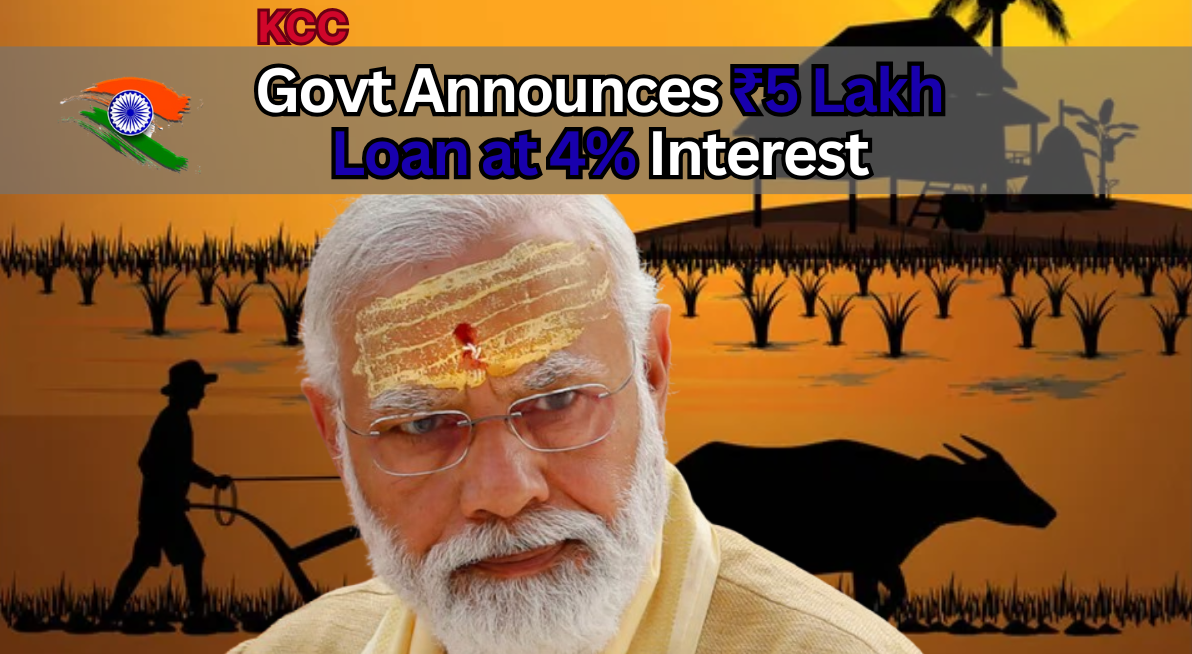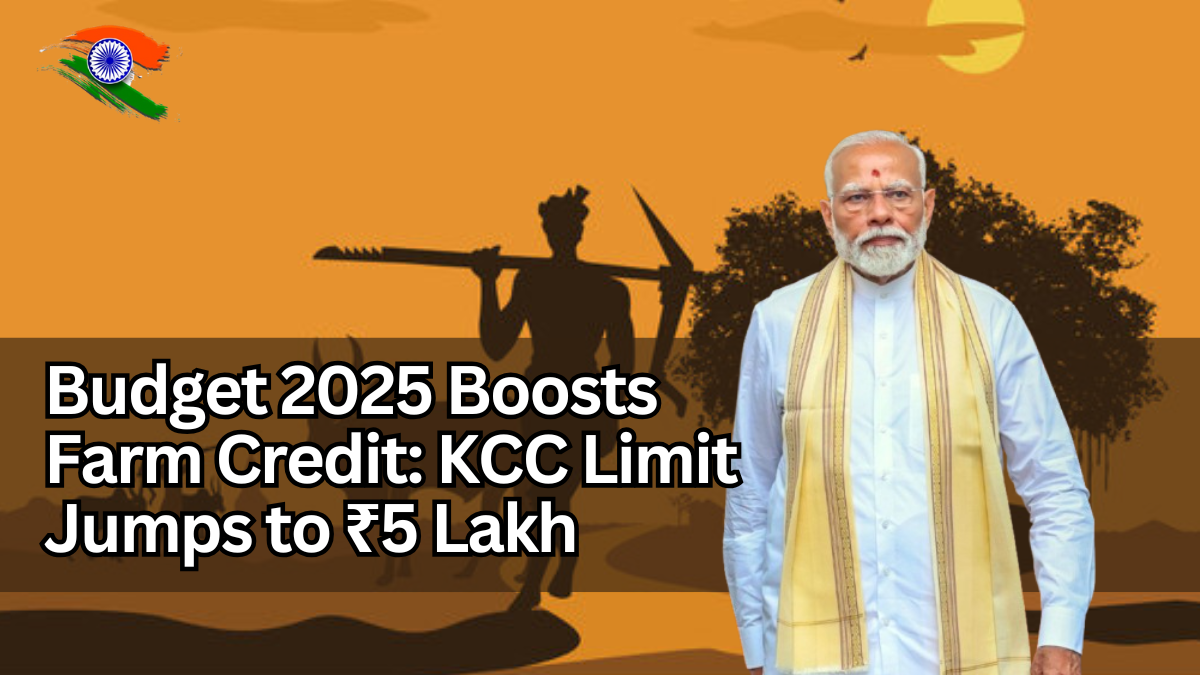With 46.1% of India’s population engaged in agriculture, ensuring farmers have access to affordable credit remains crucial for the nation’s economic stability. The Union Budget 2025-26 delivers significant relief by increasing the Kisan Credit Card (KCC) loan limit from ₹3 lakh to ₹5 lakh under the Modified Interest Subvention Scheme. This enhancement promises to transform how India’s 7.75 crore farmers access institutional credit for their agricultural needs.

The timing couldn’t be better. As agricultural costs continue rising and farmers seek financial support for everything from seeds to equipment, this budget announcement addresses a critical gap in rural financing. For millions of small and marginal farmers who constitute the backbone of Indian agriculture, this increase opens doors to greater financial flexibility and growth opportunities.
But what does this change mean for farmers on the ground? How will it impact agricultural productivity and rural livelihoods? Let’s explore the details of this significant policy shift and its implications for India’s farming community.
Understanding the Kisan Credit Card Scheme
The Kisan Credit Card scheme, launched in 1998, serves as a financial lifeline for farmers across India. This government initiative provides easy access to affordable credit for agricultural needs, functioning much like a debit card that farmers can use at ATMs and banking outlets.
The scheme addresses multiple financial requirements that farmers face throughout the agricultural cycle. From purchasing seeds and fertilizers to covering post-harvest expenses, the KCC offers comprehensive support. Additionally, it extends beyond cultivation to include household consumption needs, working capital for farm assets, and investment credit for allied activities like animal husbandry and fisheries.
Under the current structure, farmers receive loans at a subsidized interest rate of 7% for amounts up to the specified limit. The government provides a 1.5% interest subvention to lending institutions, while farmers who repay on time receive an additional 3% incentive, effectively reducing their interest burden to just 4% annually.
This makes KCC one of the most affordable credit options available to farmers in India, significantly undercutting commercial lending rates and informal money lending practices that often exploit rural communities.
Key Features of the Enhanced Scheme
The Budget 2025 enhancement brings several important changes to the KCC framework. The most significant is the loan limit increase from ₹3 lakh to ₹5 lakh, providing farmers with 67% more access to subsidized credit for their agricultural operations.
This increase maintains the existing interest structure, ensuring that farmers continue to benefit from the 4% effective interest rate after prompt repayment incentives. For specialized sectors, the scheme continues to offer collateral-free loans up to ₹1.60 lakh for animal husbandry, dairying, and fisheries activities.
The enhanced limit applies specifically to short-term agricultural loans under the Modified Interest Subvention Scheme. These loans typically have a repayment period aligned with the crop cycle, usually within 12 months, though the overall credit limit can be renewed annually with potential increases of up to 10% for five consecutive years.
Banks can provide loans without collateral for amounts up to ₹2 lakh, making credit accessible even to farmers who lack significant assets. For loans exceeding this threshold, traditional collateral requirements may apply, though the increased limit means more farmers can access substantial credit without security concerns.
Digital Infrastructure Supporting the Scheme
The Kisan Rin Portal (KRP), launched in September 2023, has revolutionized the administrative aspect of the KCC scheme. This digital platform addresses previous inefficiencies where banks manually submitted claims for Interest Subvention and Prompt Repayment Incentives to the Reserve Bank of India and NABARD.
By December 2024, the KRP had processed claims worth ₹108,336.78 crore, with approximately 5.9 crore farmers currently benefiting under the MISS-KCC scheme being mapped through the portal. This digitization ensures faster processing times, reduced paperwork, and more transparent transactions between farmers, banks, and government agencies.
The portal’s implementation has streamlined the entire credit delivery mechanism, ensuring that benefits reach farmers more efficiently. This technological backbone supports the expanded loan limits by providing the infrastructure necessary to handle increased transaction volumes and more complex credit arrangements.
Impact on Agricultural Credit Flow
The numbers tell a compelling story of the KCC scheme’s growth and impact. Institutional credit disbursement through KCC has increased dramatically from ₹4.26 lakh crore in 2014 to ₹10.05 lakh crore by December 2024. Overall agricultural credit flow has similarly expanded from ₹7.3 lakh crore in 2013-14 to ₹25.49 lakh crore in 2023-24.
Perhaps most significantly, the proportion of small and marginal farmers accessing agriculture loans has grown from 57% in 2014-15 to 76% in 2023-24. This demonstrates the scheme’s success in reaching its intended beneficiaries rather than being captured by larger agricultural operations.
The government’s financial commitment to supporting this credit flow is substantial. In the last 10 years, ₹1.44 lakh crore of interest subsidy has been released on KCC loans, with annual subsidies increasing nearly 2.4 times from ₹6,000 crore in 2014-15 to ₹14,252 crore in 2023-24.
Benefits for Different Types of Farmers

The enhanced KCC limit offers particular advantages for different categories of agricultural producers. Small and marginal farmers, who often struggle to access formal credit, can now finance larger agricultural investments without resorting to informal money lenders who charge exorbitant interest rates.
For crop farmers, the increased limit enables investment in better quality inputs, advanced farming techniques, and post-harvest infrastructure. This can translate into higher yields, better crop quality, and reduced post-harvest losses.
Livestock farmers and those engaged in fisheries benefit from dedicated provisions within the scheme. The expansion in 2019 to include animal husbandry, dairying, and fisheries has resulted in 44.40 lakh KCC cards being issued for animal husbandry activities and 1.24 lakh cards for fisheries operations.
The scheme also supports tenant farmers and sharecroppers, traditionally excluded from formal banking systems due to lack of land ownership documents. By accepting alternative documentation and focusing on cultivation rather than ownership, KCC promotes financial inclusion across different farming arrangements.
Application Process and Eligibility
Applying for a KCC has been simplified through both online and offline channels. Farmers can visit their bank’s website, fill out the application form, and submit it digitally, with banks typically responding within 3-4 days. Alternatively, they can visit the nearest bank branch for in-person assistance.
Eligibility extends to individual farmers, tenant cultivators, sharecroppers, and members of joint liability groups or self-help groups engaged in farming activities. This broad eligibility criteria ensures that various forms of agricultural engagement are supported, not just traditional land ownership.
Required documentation includes identity and address proof, passport photographs, land ownership or cultivation documents, and details of cropping patterns. For loans exceeding ₹1.60 lakh, additional security documents or guarantees may be required.
The application process considers factors such as crop type, land size, cultivation costs, and use of agricultural machinery to determine the appropriate credit limit. This personalized approach ensures that loan amounts align with actual farming needs rather than applying blanket limits.
Addressing Agricultural Finance Challenges
The enhanced KCC scheme addresses several persistent challenges in agricultural financing. Traditional banking systems often view agriculture as high-risk, leading to limited credit availability and higher interest rates. By providing government backing and interest subsidies, KCC makes agricultural lending attractive to financial institutions.
The scheme also tackles the problem of seasonal cash flow mismatches that plague farming communities. Agricultural income is typically concentrated around harvest periods, while expenses occur throughout the cultivation cycle. KCC provides the working capital necessary to bridge these gaps.
Furthermore, the scheme reduces dependence on informal credit sources, which often charge interest rates of 24-36% annually. By providing institutional credit at 4% effective interest rate, KCC saves farmers substantial amounts that would otherwise go to money lenders.
The digital infrastructure supporting the scheme addresses transparency concerns and reduces the scope for corruption or delays that previously plagued agricultural credit delivery systems.
Looking Ahead: Agricultural Transformation
The Budget 2025 enhancement of KCC limits represents more than just increased credit access it signals the government’s commitment to agricultural modernization and farmer welfare. This policy change, combined with complementary initiatives like enhanced urea production and supply chain improvements, creates a comprehensive support ecosystem for agriculture.
The increased credit limits enable farmers to invest in climate-resilient farming practices, adopt new technologies, and diversify into allied activities. This can contribute to the government’s goal of doubling farmers’ income while making agriculture more sustainable and productive.
However, the success of this enhancement will depend on effective implementation at the grassroots level. Banks must be equipped to handle increased loan volumes, and farmers need awareness about the enhanced benefits available to them.
The scheme’s expansion also aligns with broader digitalization efforts in agriculture, from direct benefit transfers to digital market linkages. As rural India becomes increasingly connected, KCC can serve as a foundation for more sophisticated financial services tailored to agricultural needs.
The Budget 2025 enhancement of Kisan Credit Card limits from ₹3 lakh to ₹5 lakh represents a significant step forward in agricultural finance reform. By providing farmers with greater access to affordable institutional credit, this policy change has the potential to transform rural livelihoods and boost agricultural productivity across India. Success will depend on effective implementation, continued digital infrastructure development, and maintaining the delicate balance between supporting farmers and ensuring fiscal responsibility. For India’s farming community, this enhancement offers new opportunities for growth, modernization, and financial independence.
FAQs About KCC Scheme 2025
1. What is the Kisan Credit Card (KCC) scheme?
The KCC scheme is an initiative by the Indian government to provide farmers with easy access to affordable agricultural credit. It helps cover crop production needs, farm equipment purchases, and other agricultural expenses.
2. What is the new KCC loan limit?
Under the Union Budget 2025, the KCC loan limit has been increased from ₹3 lakh to ₹5 lakh, allowing farmers to access higher credit facilities.
3. What is the interest rate on KCC loans?
Farmers can avail of KCC loans at a subsidized interest rate of 4%, which significantly reduces the financial burden on the farming community.
4. Who is eligible for the KCC scheme?
All farmers involved in agricultural activities, including crop cultivation, fisheries, and animal husbandry, are eligible for the KCC scheme, subject to specific terms and conditions.
5. How can farmers apply for a KCC loan?
Farmers can apply for a KCC loan through authorized banks, either online or by visiting the nearest branch. They need to submit required documents, such as proof of identity, land records, and details of agricultural activities.
6. How will the increased loan limit benefit farmers?
The enhanced loan limit provides farmers with greater financial flexibility to invest in modern equipment, better inputs, and advanced farming methods, thereby boosting productivity and income.
7. Are there penalties for late repayment of KCC loans?
Yes, late repayment of KCC loans may attract penalties as per bank guidelines. Farmers are advised to repay loans on time to maintain a good credit score and avoid additional charges.
For More Information Click HERE
